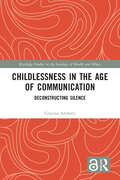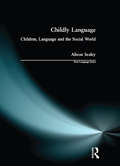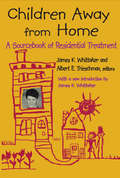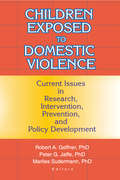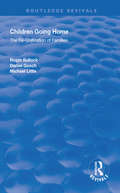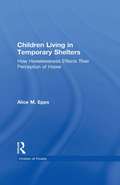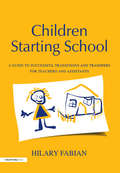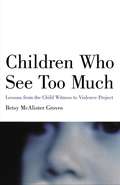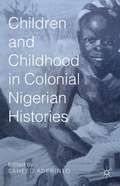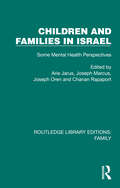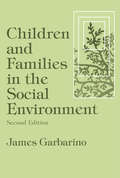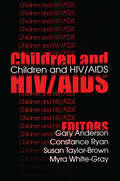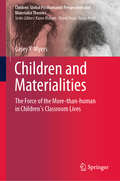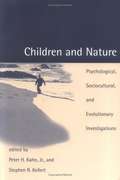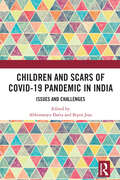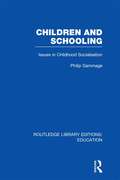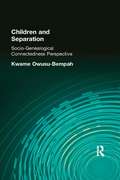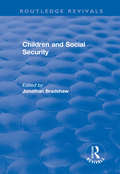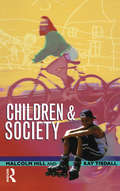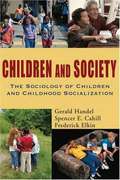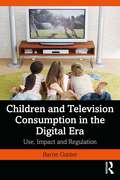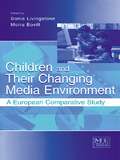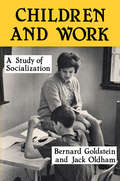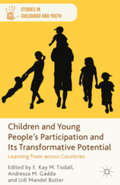- Table View
- List View
Childlessness in the Age of Communication: Deconstructing Silence
by Cristina ArchettiCristina Archetti started researching childlessness after being diagnosed with "unexplained infertility". She soon discovered that, although involuntary childlessness affects an increasing number of women and men across the world, this topic is shrouded taboo and shame. This book is both a first-person reflection about the existential questions posed by involuntary childlessness and a readable account of the way the silence surrounding this topic is socially and politically constructed. Revealing the invisible mechanisms that, from the microscopic details of everyday life to policy, make up the structure of silence around childlessness, Archetti demonstrates what it means not to have children in a society that is organized around families. Through a prose that mixes analysis, excerpts of interviews, media fragments, and evocative writing, she develops a new language of feeling-in-the-body fit for the twenty-first century and exposes the devastating effects infertility has on relationships, identity, health and well-being, in societies that fetishize parenthood. Childlessness in the Age of Communication draws upon a range of disciplines and fields including sociology, health, gender and sexuality studies, communication, politics and anthropology. It is a book for all those interested in childlessness and innovative qualitative research methodologies.
Childly Language: Children, language and the social world (Real Language Series)
by Alison SealeyChildly Language explores how attitudes and cultural assumptions about children and childhood are revealed in contemporary English. It addresses such questions as: How is concern for children's safety and welfare reflected in the vocabulary and grammar of contemporary English? and When we say that an adult is being 'childish', what are we saying about the characteristics of children?
Children Away from Home: A Sourcebook of Residential Treatment
by James K. Whrttater Albert E. TrieschmanThe editors of this volume are committed to the philosophy of treating emotionally disturbed children in the life milieu. Both have been intensely involved in training "online" therapists--child care workers. They are convinced that there is no one "right way" in milieu treatment, and propose a electric model for treatment.Like many of the other writers included in this book, Whittaker and Trieschman conceive of treatment as a total life experience. Th ey do not see the individual versus the group, but the individual within the group situation. They also do not see permissiveness versus limitations, professional staff versus nonprofessional staff , or the institution versus an outside of the community.The book is divided into two sections: the fi rst is a dialogue between the editors on current issues in residential treatment and problems in treating children. The second is a collection of readings. This is one of the first sourcebooks covering the therapeutic milieu for children in residential treatment centers, specifi cally emotionally disturbed children. It is also an excellent text for courses on the emotionally disturbed child, milieu treatment, and child welfare.
Children Exposed to Domestic Violence: Current Issues in Research, Intervention, Prevention, and Policy Development
by Peter JaffeDiscover research from across the United States and around the world on children exposed to domestic violence!If you are a member of a helping, medical, or legal profession, Children Exposed to Domestic Violence: Current Issues in Research, Intervention, Prevention, and Policy Development will help you explore research, assessments, interventions, and policy and prevention for children, victims of battering, batterers, and their families. This important book focuses on various aspects of spousal/partner abuse and child maltreatment. Comprehensive and thorough, Children Exposed to Domestic Violence focuses on three major sections: theoretical and research issues, intervention and prevention strategies, and policy development from an international perspective. Some of the important issues you will examine include: exploring the importance of partnerships between the domestic violence front-line workers and researchers at universities addressing the thorny issues of parenting in abused women assessing all areas of children's adjustment as well as their various relationships that may be problematic investigating the results of a quarter century research on men who batter by focusing on the crucial link between exposure to violence in childhood and adult marital behavior understanding the role of physiological and environmental factors as central to the role in domestic violence exploring the challenges faced by shelter staff in providing services to children who accompany their mother to find refuge examining new ideas for primary prevention programs in schools understanding policy and legislative implications of the growing body of literature on the impact of exposure to violence on children Children Exposed to Domestic Violence exemplifies the serious challenges faced by social workers, educators, policymakers, psychologists and others in helping professions working with children who have been exposed to domestic violence. You will gain insight into the vast amount of research that has taken place in the last ten years on this problem that will assist you with creating research ideas, interventions, prevention programs, and policies concerning children exposed to domestic violence.
Children Going Home: The Re-unification of Families (Routledge Revivals)
by Roger Bullock Michael Little Daniel GoochFirst published in 1998, this Darlington child care study looks at the return experiences of children looked after by local authorities. It shows that although the great majority of children go back to their families and home communities, little is known about the process. How can professionals and carers make the transition as easy as possible? The book takes forward ideas first reported in the Dartmouth publication, going home: The return of children separated from their families and tested in subsequent research. It charts patterns of separation and return, considers the experiences of those involved and highlights factors associated with the likelihood of return and its success. Because the factors described in the earlier research have since been confirmed in a blind prospective study they are among the most robust indicators available.
Children Living in Temporary Shelters: How Homelessness Effects Their Perception of Home (Children of Poverty)
by Alice M. EppsFirst published in 1998. Routledge is an imprint of Taylor & Francis, an informa company.
Children Starting School: A Guide to Successful Transitions and Transfers for Teachers and Assistants
by Hilary FabianDrawing on research, theory and practice, this book presents ways in which practitioners, working in partnership with parents, can give children a successful start to school. Written in an accessible style, the book helps early years practitioners planning transition programs for new children and offers ideas for developing their professional practice when working with families. Starting school at the age of four or five is recognized as a major adjustment in a child's life that can determine his or her future success in education. This book highlights the factors that influence children's early adjustment, including their social and emotional wellbeing, so that schools can learn the best way to offer support. Practitioners, managers and those studying on early childhood courses will gain an understanding of the complexity and diversity of transition and will learn how they can make this a stress-free time for the children, families and professionals involved.
Children Who Fail at School But Succeed at Life: Lessons from Lives Well-Lived
by Mark KatzUnderstanding resiliency and student success by studying people who succumbed to risk but later triumphed. A number of people who failed in school currently enjoy meaningful and successful lives. They include, though they are by no means limited to, those with attention and executive function challenges, learning disabilities, learning and behavioral challenges arising out of traumatic events in their lives, and even those impacted by all of the above. Up until recently, little attention was paid to successful people who did poorly in school. Why? One reason might be that many of us doubted that it was actually possible. After all, many loving parents and caring teachers spent countless hours trying their hardest to help these failing children turn things around in school, sometimes with little or nothing to show for it. If these children continued to struggle and fail in school with all this help and support, it was understandable to assume that they would not succeed in the real world decades later without it. So what did we miss? Why were we so wrong about them? And perhaps most importantly, how can their life experiences help educators and parents understand what schools can do better to support students who are struggling today? In his groundbreaking new book, Mark Katz draws on research findings in clinical and social psychology, cognitive neuroscience, education, and other fields of study--as well as stories of successful individuals who overcame years of school failure--to answer these and other questions. In the process, he shows how children who fail at school but succeed at life can give teachers and schools, counselors and health care professionals, parents and guardians--even those whose childhood struggles have persisted into their adult years--new remedies for combatting learning, behavioral, and emotional challenges; reducing juvenile crime, school dropout, and substance abuse; improving our health and well-being; and preventing medical problems later in life.
Children Who See Too Much: Lessons From The Child Witness To Violence Project
by Betsy Mcalister GrovesFor the last ten years Betsy Groves has been working with children traumatized by witnessing violence. In this book she shows how children understand, respond to, and are affected by violence, especially domestic violence. Groves makes the powerful case that traumatic events carried out by family members carry the most severe psychological risks for very young children. She uses clinical case studies to show that being young does not protect against the lasting effects of witnessing violence, and she offers ways adults can help.
Children and Childhood in Colonial Nigerian Histories
by Saheed AderintoThis book brings together the newest and the most innovative scholarship on Nigerian children—one of the least researched groups in African colonial history. It engages the changing conceptions of childhood, relating it to the broader themes about modernity, power, agency, and social transformation under imperial rule. Contributors detail everyday interaction of children with the socio-political and economic infrastructure of colonialism and demonstrate that they played a significantbut rarely acknowledged role in molding core ideas about colonial modernity and civilization. Children and Childhood in Colonial Nigerian Histories fills a major gap in African studies by presenting the historical roots of some of the main issues about children' experience in postcolonial Nigeria. It argues that colonial history of children is important for understanding the challenges of childhood in contemporary Nigeria.
Children and Families in Israel: Some Mental Health Perspectives (Routledge Library Editions: Family)
by Arie Jarus Joseph Marcus Joseph Oren Chanan RapaportOriginally published in 1970, this title was intended to describe a wide and complex network of historical, social, psychological and medical issues. It starts with an overview of Israel as a society and how it is similar yet differs from that the reader may be familiar with. Divided into three parts, the first looks at the basic fabric and main patterns of social and psychological issues in Israel and provides the background for specific mental health problems. The second part deals with selected groups of population, or problem areas which are of special interest from the viewpoint of mental health issues, and that receive special attention by the society itself. This includes the child outside his family, the immigrant child absorbed by the program of Youth Aliyah, socially deprived or vulnerable children, those with disabilities, and delinquency. The final part deals with ways and means of providing service and care for those who eventually need attention. This includes descriptions of the mental health professions, the available psychiatric services, the role of voluntary agencies in providing care, and finally a discussion of issues in planning and research. Today it can be read in its historical context.
Children and Families in the Social Environment: Modern Applications of Social Work (Modern Applications Of Social Work Ser.)
by James GarbarinoThe first edition of this volume successfully applied Bronfenbrenner's "micro-systems" taxonomy to childrearing and family life. Emphasizing how forces in the environment influence children's behavior, Garbarino has staked out an intermediate position between the psychoanalytic and the systems approach to human development. Taking cognizance of new research and of changes in American society, Garbarino has once again carefully analyzed the importance of children's social relationships. For this wholly revised second edition, he has incorporated a greater emphasis on ethnic, cultural, and racial issues.
Children and HIV/AIDS
by Gary Anderson Susan Taylor-Brown Constance Ryan Myra White-GrayIn December 1982, the Centers for Disease Control received the first reports of cases of children with HIV/AIDS. Since that time, the child welfare system, as well as other human service organizations, have been coping with and responding to the crises of children and families living with HIV/AIDS, including the considerable number of children affected by AIDS through the illness of their parents, siblings, or other family members. This volume is intended as a resource for personnel within the child welfare field serving children and families whose lives are touched by HIV and AIDS. The contributors add insight to and fuel the discussion of the fight against AIDS. They provide tools to help better serve the children and adolescents that the current epidemic so tragically affects. Chapters and contributors include: "Factors Associated with Parents' Decision to Disclose Their HIV Diagnosis to Their Children" by Lori S. Wiener, Haven B. Battles, and Nancy E. Heilman; "Custody Planning with HIV-Affected Families" by Sally Mason; "Correlates and Distribution of HIV Risk Behaviors Among Homeless Youths in New York City" by Michael C. Clatts, W. Rees Davis, J. L. Sotheran, and Aylin Attillasoy; and "HIV Prevention for Youths in Independent Living Programs" by Wendy F. Auslander, Vered Slonim-Nevo, Diane Elze, and Michael Sherraden. Originally published as a special issue of 'Child Welfare', this volume examines lessons learned from a variety of perspectives and settings, and identifies a number of continuing challenges facing the field. 'Children and HIV/AIDS' is an invaluable compendium that should be read by social workers and health specialists and all those affected by the epidemic.
Children and Materialities: The Force of the More-than-human in Children’s Classroom Lives (Children: Global Posthumanist Perspectives and Materialist Theories)
by Casey Y. MyersThis book makes the case for young children as both keenly materially aware of and highly dependent on sets of interrelated material-discursive circumstances. It argues that long-term engagement with children around the topic of meaning-matter relations upends many taken-for-granted notions of consumption, self-regulation, knowledge production, and what constitutes quality of life within a school setting.The book provides complex accounts of agency on multiple scales - the capability of children to shape and share research, the force of objects, stuff, and things to impact the "social" workings of a classroom, and the impact of nonhuman animals on the trajectory of the ways in which children relate to each other.This work makes a significant contribution to both theoretical conceptions and practical enactments of childhoods, productively addressing the many contradictions inherent in a posthuman and participatory approach to researching with young children. It also offers insights into how the everyday materialities of children’s classrooms (and their complex representations) are capable of disrupting the common-sense order of things.
Children and Nature: Psychological, Sociocultural, and Evolutionary Investigations
by Peter H. Kahn Stephen R. Kellert<p>For much of human evolution, the natural world was one of the most important contexts of children's maturation. Indeed, the experience of nature was, and still may be, a critical component of human physical, emotional, intellectual, and even moral development. Yet scientific knowledge of the significance of nature during the different stages of childhood is sparse. This book provides scientific investigations and thought-provoking essays on children and nature. <p>Children and Nature incorporates research from cognitive science, developmental psychology, ecology, education, environmental studies, evolutionary psychology, political science, primatology, psychiatry, and social psychology. The authors examine the evolutionary significance of nature during childhood; the formation of children's conceptions, values, and sympathies toward the natural world; how contact with nature affects children's physical and mental development; and the educational and political consequences of the weakened childhood experience of nature in modern society.</p>
Children and Scars of COVID-19 Pandemic in India: Issues and Challenges
by Abhimanyu Datta Bipin JojoThis volume discusses the various challenges faced by children in India from different perspectives such as education, psychology, and sociology during the COVID-19 pandemic. It highlights the nature of undocumented struggles of refugees, children with special needs, girl children/ girl child, child labourers, children from SC/ST and other disadvantaged communities and migrant children in India. The book examines the lack of a social justice framework to cater to children’s needs and wellbeing. It discusses how intersectional location of these children in caste, class, gender, ethnicity, and religious locations shape their ability to access welfare and rights across sectors such as health, education, nutrition, and security. The book puts forth recommendations to ensure better intervention mechanisms to address issues faced by children from all sections of society and paves the way to counter the emerging challenges in future.This book will be of interest to students, teachers, and researchers of education, psychology, sociology, social work, childhood studies, and development studies. It will also be useful for educationalists, sociologists, social psychologists, lay public and those interested in exploring the condition of various marginalized children in India.
Children and Schooling: Issues In Childhood Socialization (Routledge Library Editions: Education)
by Phillip GammageThe book provides a synthesis of a broadly-based social-psychology of education and bridges the gap between theory and practice in education by emphasising the relationship between research and actuality. The author discusses the major issues in childhood socialisation relating to schooling, achievement and the curriculum, and in so doing makes a sensitive and well-argued case for the social-psychological perspective.He presents a social-psychologist’s view of the interaction between child, school and curriculum, and summarises mainstream psychological contributions to current thinking on achievement, self-esteem and education. He covers areas of social learning and attribution theory not commonly dealt with in education texts, showing that there are major fields of research which have until now been neglected. Children and Schooling is constructed so that its chapters can be used as independent study-guides to specific subjects or read in sequence, each subject inter-related. The text can be treated as an introduction, particularly in view of the notes and comprehensive and apposite scholarly apparatus: and as a spring-board for serious study at advanced level.
Children and Separation: Socio-Genealogical Connectedness Perspective
by Kwame Owusu-BempahChildhood separation and loss have become virtually a way of life for a large number of children throughout the world. Children separated from their genetic parent(s) and consequently their genealogical, social and cultural roots due to processes such as adoption, parental divorce/separation, donor insemination, single parenthood by choice and child trafficking can face social, emotional and psychological difficulties. This book explores the premise that a proper understanding of the complex inner world of modern day separated children and their psycho-social development requires a shift in focus or emphasis. It presents the notion of socio-genealogical connectedness as a new theoretical framework for studying and promoting these children's growth and development. This new theory simultaneously challenges and complements existing notions of psycho-social development, including attachment theory and Erikson's psycho-social theory of personality development. Owusu-Bempah proposes that this sense of socio-genealogical connectedness is an essential factor in children's adjustment to separation and their emotional and mental health; much like those adopted, separated children suffer a loss of genealogical continuity, and hence, loss of 'self'. This hypothesis is discussed and ultimately supported through both the author's own research and a broad selection of theoretical and empirical material from other areas. The book further considers the implications of this notion of socio-genealogical connectedness for childcare policy and practice, as well as directions for future research in this and related fields. Children and Separation is an invaluable resource for academics, students and childcare professionals. The accessible style of the book ensures that it will also be useful to parents and anybody affected by childhood separation.
Children and Social Security
by Jonathan BradshawThis title was first published in 2003. There is growing anxiety about the consequences of social and economic change for children in industrial countries. It is in this context that the Federation for International Studies in Social Security chose Children and Social Security as the theme of its conference held in June 2001. Leading academics came together to discuss issues such as international comparative studies of child poverty, financial benefit packages for children, aspects of social security provision for families with children. This volume is international in focus bringing together research from the US, Europe, South Africa, New Zealand it should be useful to researchers of social policy, economics, sociology and politics, as well as policy-makers and representatives of charities and international bodies.
Children and Society
by Kay Tisdall Malcolm HillProvides a comprehensive overview of the issues, research and debates relating to children and the experience of childhood in late twentieth century Britain. This volume will address key issues such as juvenile crime, poverty, child protection and children's rights and their implications for the development of policy and services for children. Presents first hand accounts from children and parents.
Children and Society: The Sociology of Children and Childhood Socialization
by Gerald Handel Spencer Cahill Frederick ElkinChildren and Society presents a comprehensive sociological portrayal of children and childhood from birth to the beginning of adolescence. A major theme is the tension between children's active agency and the socializing influences of the family, school, peer groups, and mass media. The book incorporates the most recent research and theories of childhood socialization. Its theoretical perspective is primarily symbolic interactionism which emphasizes the development of the self. The volume features research that documents cultural variations within American society shaped by social class, race and ethnicity, and gender.
Children and Television Consumption in the Digital Era: Use, Impact and Regulation
by Barrie GunterChildren and Television Consumption in the Digital Era provides a comprehensive analysis of contemporary research on the developmental impact of children’s screen engagement in modern society. Barrie Gunter explores how the world of television has evolved to become almost unrecognisable from the broadcast landscapes present over the last years of the 20th century. This key text considers how screen-based entertainment has become increasingly interactive, and how children have become accustomed to creating their own television schedules through streamed services. It explores key topics including screen experiences and the manifestation of prosocial and antisocial behaviour, advertising and the development of consumerism, and the evidence of screen time on a child’s health and school performance. Gunter insightfully assesses television content that children are exposed to and its impact on cognitive and behavioural development. Featuring commentary on the challenges regulators face to keep up with rapidly developing screen technologies and suggestions on how parents can mediate their children’s screen behaviour, this text is an essential read for researchers and students taking courses in child development, family studies, broadcasting and communication.
Children and Their Changing Media Environment: A European Comparative Study (Routledge Communication Series)
by Sonia Livingstone Moira BovillFocusing on the meanings, uses, and impacts of new media in childhood, family life, peer culture, and the relation between home and school, this volume sets out to address many of the questions, fears, and hopes regarding the changing place of media in the lives of today's children and young people. The scholars contributing to this work argue that such questions--intellectual, empirical, and policy-related--can be productively addressed through cross-national research. Hence, this volume brings together researchers from 12 countries--Belgium, Denmark, Finland, France, Germany, the United Kingdom, Israel, Italy, the Netherlands, Spain, Sweden, and Switzerland--to present original and comprehensive findings regarding the diffusion and significance of new media and information technologies among children. Inspired by parallels and difference between the arrival of television in the family home during the 1950s and the present day arrival of new media, the research is based on in-depth interviews and a detailed comparative survey of 6- to 16-year-olds across Europe and in Israel. The result is a comprehensive, detailed, and fascinating account of how these technologies are rapidly becoming central to the daily lives of young people. As a resource for researchers and students in media and communication studies, leisure and cultural studies, social psychology, and related areas, this volume provides crucial insights into the role of media in the lives of children. The findings included herein will also be of interest to policymakers in broadcasting, technology, and education throughout the world.
Children and Work: Study of Socialization
by Bernard Goldstein; Jack OldhamWhat do children know about work, careers, and related topics? What is the pattern of growth in values, attitudes, beliefs, and knowledge? Using quantitative and anecdotal evidence gathered from interviewing over 900 grade-school students in five New Jersey communities, the authors analyze childhood socialization to the concept of work.Existing literature on this topic focuses on the critical years of oc-cupational choice. But Goldstein and Oldham strongly suggest that much of the child's work-related development has already occurred prior to entry into secondary school, and that "career education" must receive increased emphasis during the elementary years. Their evidence corroborates the pattern of rapid progress toward childhood awareness of important social phenomena such as war, politics, race, gender roles, and economics. By the seventh grade, children have an awareness in these areas that approximates that of adults. Traditional stereo-types concerning appropriate work roles for women continue to exist at the elementary school level. This work is a comprehensive, empirical treatment of childhood socialization to work, fitting neatly into the growing body of litera-ture on the socialization of the child into various political, economic, and social roles. Children and Work is in the sociological tradition, but the findings are presented in the context of a growing body of social science research on early socialization.
Children and Young People’s Participation and Its Transformative Potential: Learning From Across Countries (Studies In Childhood And Youth Series)
by E. Kay M. TisdallBringing together theories, ideas, insights and experiences of practitioners and researchers from Brazil, India, South Africa and the UK, this book explores children and young people's involvement in public action. The contributors consider the potential of children and young people's participation to be transformative.
